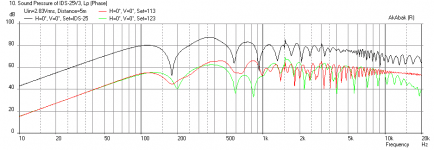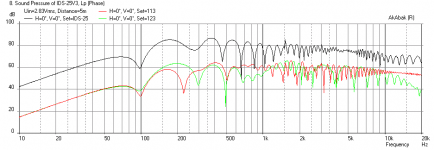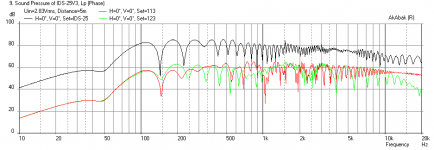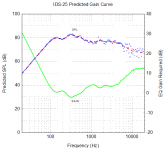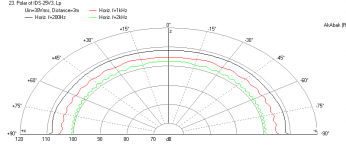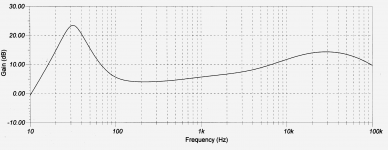I think the low end active EQ will force both the TG and the TC drivers to do the same thing (peak at 32HZ), assuming a poweramp that has less than an ohm output impedance. That's part of what I love about active EQ. With a closed box, you can tell it to do whatever you want. I've been using it on all my woofers for decades. Low bass is especially good for making drums come to life, not just bass instruments or sound effects in movies. The overall sound is so much warmer.
Off subject a bit: I just got done (sort of) cutting up a bunch of wood to build my version of an AR4X. It's a small 2 way bookshelf that I used to desperately want when I was in gradeschool (mid 60's), made by Acoustic Research. I have these 8 inch polykevlar Focal brand drivers sitting in a box under my bench, for the last 10+ years, (cost $150 ea.) and decided I have to do something with them. The tweeter will be either a TG or a TC 3 inch Vifa. The subenclosure will be a section of 3 inch inner diameter PVC pipe that goes all the way to the back of the cabinet and is stuffed with acoustic insulation. I'll put active EQ ahead of the poweramp so the 8 inch woofer is somewhat acoustically flat down to 32HZ. 1 pole passive xover will be around 600HZ. I'm actually kind of excited about it. It may sound spectacular. If I had a more stable living space I'd build the IDS25. My future is getting hard to predict ever since the Republican mafia opened the gates for the self propelling movement of jobs from here to China back in the early 1980's. Jobs that can use my skill set have gotten VERY rare.
Off subject a bit: I just got done (sort of) cutting up a bunch of wood to build my version of an AR4X. It's a small 2 way bookshelf that I used to desperately want when I was in gradeschool (mid 60's), made by Acoustic Research. I have these 8 inch polykevlar Focal brand drivers sitting in a box under my bench, for the last 10+ years, (cost $150 ea.) and decided I have to do something with them. The tweeter will be either a TG or a TC 3 inch Vifa. The subenclosure will be a section of 3 inch inner diameter PVC pipe that goes all the way to the back of the cabinet and is stuffed with acoustic insulation. I'll put active EQ ahead of the poweramp so the 8 inch woofer is somewhat acoustically flat down to 32HZ. 1 pole passive xover will be around 600HZ. I'm actually kind of excited about it. It may sound spectacular. If I had a more stable living space I'd build the IDS25. My future is getting hard to predict ever since the Republican mafia opened the gates for the self propelling movement of jobs from here to China back in the early 1980's. Jobs that can use my skill set have gotten VERY rare.
Your AR4X project sounds pretty neat. The Vifa makes a nice tweeter and is used in the Manzanita OB as one. Not the most efficient but if you stack two together and drive at 4 ohms it is pretty good.
Effect of Wall on IDS-25 Response w/o EQ
Here are the sims of the effect of a rear wall.
- SPL vs Freq for cabinet back 6 in away from wall
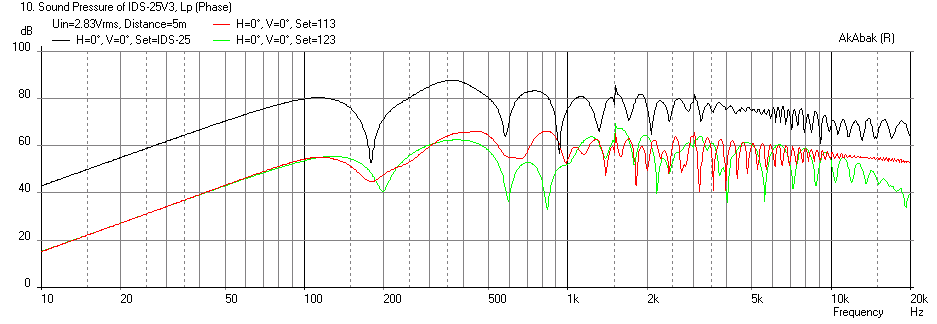
- SPL vs Freq for cabinet back 24 in away from wall
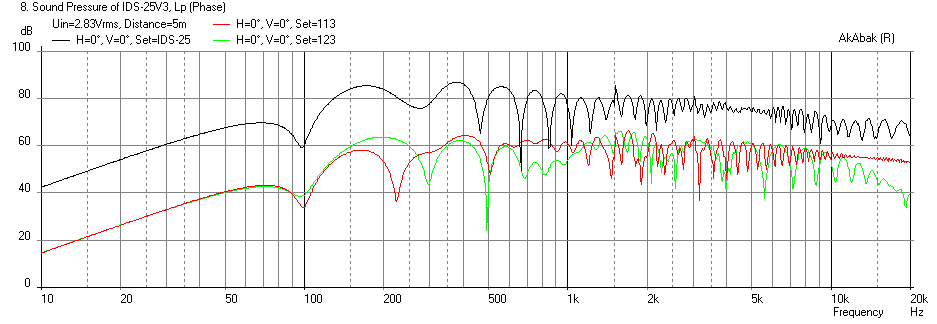
- SPL vs Freq for cabinet back 60 in away from wall
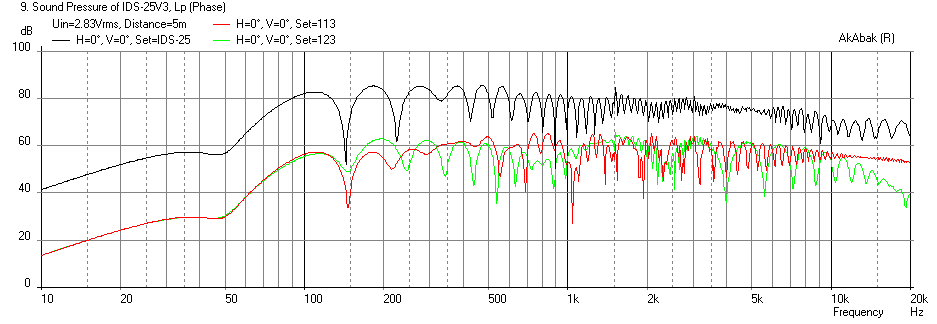
All for 1 watt input with mic at 5 meters away and located 24 in off the floor.
Here are the sims of the effect of a rear wall.
- SPL vs Freq for cabinet back 6 in away from wall

- SPL vs Freq for cabinet back 24 in away from wall

- SPL vs Freq for cabinet back 60 in away from wall

All for 1 watt input with mic at 5 meters away and located 24 in off the floor.
Attachments
Predicted IDS-25 EQ Gain Curve
Based on the results of my simulation, I came up with the following EQ gain profile for the 25 driver TC9FD array.
Here is the plot of the SPL vs Freq and the Gain Curve derived from it (green).
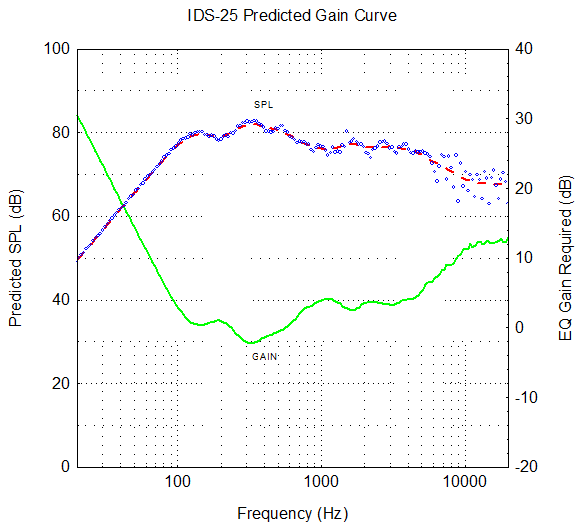
Below are the actual values of the green curve in ASCII text.
Based on the results of my simulation, I came up with the following EQ gain profile for the 25 driver TC9FD array.
Here is the plot of the SPL vs Freq and the Gain Curve derived from it (green).

Below are the actual values of the green curve in ASCII text.
Code:
Freq(Hz) Gain (dB)
11.642 38.206
12.093 37.8617
12.561 37.531
13.048 37.2095
13.553 36.8665
14.078 36.5503
14.624 35.8646
15.19 35.2342
15.778 34.5574
16.39 33.8959
17.024 33.2506
17.684 32.5665
18.369 31.9295
19.08 31.2544
19.82 30.5866
20.587 29.9516
21.385 29.2663
22.213 28.6051
23.073 27.9383
23.967 27.3041
24.896 26.6378
25.86 25.9658
26.862 25.2948
27.902 24.5981
28.983 23.9324
30.106 23.2513
31.272 22.5539
32.483 21.8843
33.742 21.2276
35.049 20.5658
36.406 19.8978
37.816 19.2162
39.281 18.5508
40.803 17.9179
42.383 17.2508
44.025 16.6158
45.731 15.9478
47.502 15.3158
49.342 14.6553
51.253 13.978
53.239 13.3074
55.301 12.6461
57.443 12.0105
59.668 11.3732
61.979 10.7139
64.38 10.0836
66.874 9.39593
69.464 8.75397
72.155 8.10476
74.95 7.45491
77.853 6.8406
80.869 6.22786
84.002 5.59193
87.256 4.96032
90.636 4.34988
94.146 3.78186
97.793 3.26319
101.581 2.75104
105.516 2.32658
109.604 1.87442
113.849 1.48654
118.259 1.13048
122.84 0.811129
127.598 0.625649
132.541 0.497892
137.675 0.457595
143.008 0.398767
148.548 0.374765
154.302 0.498387
160.279 0.608337
166.487 0.751065
172.936 0.855966
179.635 0.936032
186.594 1.04066
193.821 1.0022
201.329 0.974039
209.128 0.844853
217.229 0.646055
225.643 0.423182
234.384 0.0594745
243.463 -0.326953
252.894 -0.723054
262.69 -1.02824
272.865 -1.32354
283.435 -1.67181
294.414 -1.92645
305.818 -2.13533
317.664 -2.25569
329.969 -2.23562
342.751 -2.12234
356.028 -1.94022
369.819 -1.73402
384.144 -1.50187
399.024 -1.38018
414.481 -1.23005
430.536 -1.11599
447.214 -1.01025
464.537 -0.858215
482.531 -0.704815
501.222 -0.491859
520.638 -0.343664
540.805 -0.150206
561.754 0.0780864
583.514 0.282748
606.117 0.586916
629.595 0.874496
653.983 1.27442
679.316 1.67612
705.63 2.09542
732.963 2.51502
761.355 2.75136
790.847 2.89801
821.481 3.03177
853.302 3.11999
886.355 3.31417
920.689 3.60253
956.352 3.83596
993.398 3.89779
1030 4.06619
1070 4.09198
1110 4.09983
1160 4.04167
1200 4.0843
1250 3.76748
1300 3.67483
1350 3.48341
1400 3.12799
1450 2.89206
1510 2.82906
1570 2.65396
1630 2.5527
1690 2.56577
1760 2.75005
1830 2.9953
1900 3.38776
1970 3.50961
2050 3.61866
2120 3.69321
2210 3.6914
2290 3.63042
2380 3.61991
2470 3.65625
2570 3.53249
2670 3.48787
2770 3.38521
2880 3.33959
2990 3.31336
3110 3.2636
3230 3.30564
3350 3.46649
3480 3.7138
3620 3.92751
3760 3.99182
3900 4.10909
4050 4.1176
4210 4.07868
4370 4.1998
4540 4.36206
4720 4.64205
4900 5.05587
5090 5.54901
5290 6.17229
5490 6.4551
5710 6.52895
5930 6.61873
6160 7.21611
6400 7.31866
6640 7.63689
6900 8.34542
7170 8.31108
7450 9.13128
7730 8.94661
8030 9.04674
8350 9.16534
8670 9.95396
9000 10.3446
9350 10.3465
9720 11.231
10100 11.3802
10500 11.2191
10900 12.1651
11300 11.5275
11700 11.8485
12200 12.2379
12700 12.3674
13200 11.922
13700 12.1538
14200 12.5713
14800 12.1933
15300 12.1562
15900 12.2029
16500 12.3105
17200 12.6026
17800 12.7918
18500 12.2561
19300 12.4561
20000 13.0239Attachments
Target curve should not be linear response though.
Bruel & Kjær made some research on this topic many years ago :
http://www.bksv.com/doc/17-197.pdf
The target curve is Fig 5 in that articel and this is what I and a lot of other guys uses instead of linear response, wich is too bright.
Bruel & Kjær made some research on this topic many years ago :
http://www.bksv.com/doc/17-197.pdf
The target curve is Fig 5 in that articel and this is what I and a lot of other guys uses instead of linear response, wich is too bright.
X,
Thanks for the sims, your graph shows a lot of similarities to the EQ curve from opc:


+

Same trends, slightly different shapes. I guess it pays off to make measurements at listening position in each separate case. The second Behringer graph is his personal deviation from flat response.
Thanks for the sims, your graph shows a lot of similarities to the EQ curve from opc:


+

Same trends, slightly different shapes. I guess it pays off to make measurements at listening position in each separate case. The second Behringer graph is his personal deviation from flat response.
Last edited:
Target curve should not be linear response though.
Bruel & Kjær made some research on this topic many years ago :
http://www.bksv.com/doc/17-197.pdf
The target curve is Fig 5 in that articel and this is what I and a lot of other guys uses instead of linear response, wich is too bright.
Thanks for pointing us to this paper. Certainly a -6dB roll off from 60 Hz to 20 kHz can be implemented by having only 7 dB gain instead of the 13 dB gain if one wanted the flat response. My old ears don't hear much above 16 kHz so I probably don't mind the Vifa's sounding bright. I like their inherently flat response from 10 kHz to 20 kHz.
All files with .txt are actually of .frd format.
b🙂
Bjorno,
I am having a hard time interpreting which is the EQ curve you recommend? Can you simply post just that curve similar to what I did so we can compare and see if we arrived at similar predictions for the EQ that is needed?
Thanks
C
Thanks everybody for all the different graphs. The more we know, the better job we can do. They correlate well with what Roger Russel recommends too. When I have time, I'm going to try and do the upperband EQ with a Baxandall topology, so it will be adjustable.
We WILL get there with this. It's exciting to me to be able to be a part of Wesayso's project, and others. These are likely to be stunningly excellent speakers if the room acoustics are right (typical 9ft. or so flat ceiling and nearby walls behind speakers).
We WILL get there with this. It's exciting to me to be able to be a part of Wesayso's project, and others. These are likely to be stunningly excellent speakers if the room acoustics are right (typical 9ft. or so flat ceiling and nearby walls behind speakers).
Bob,
Yes, I agree it is exciting for us to live vicariously through Wesayso's Two Towers IDS-25 clone. From the sims I have run, these will sound amazing - the dynamics and transients coupled with how large the sound field is will be quite something to hear. I want to build these. 🙂
Check out the polar directivity of these speakers. Once EQ'd out they are essentially uniform radiators over 180 degrees with no lobing. Amazing.
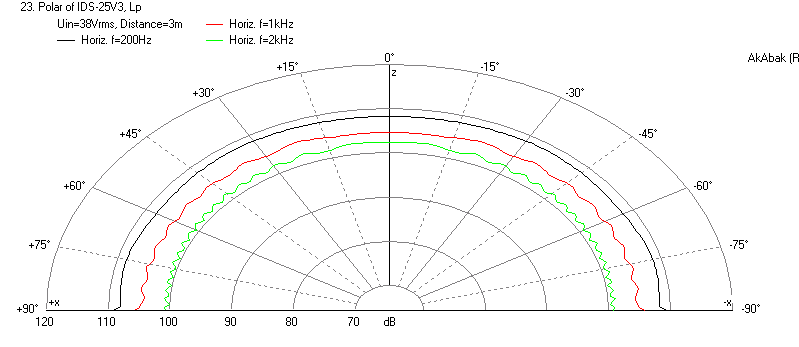
Yes, I agree it is exciting for us to live vicariously through Wesayso's Two Towers IDS-25 clone. From the sims I have run, these will sound amazing - the dynamics and transients coupled with how large the sound field is will be quite something to hear. I want to build these. 🙂
Check out the polar directivity of these speakers. Once EQ'd out they are essentially uniform radiators over 180 degrees with no lobing. Amazing.

Attachments
Last edited:
With help from xrk971 (getting the TINA program to work right), I think we may have a good circuit now to share. The 20k resistor at the positive input of the final out opamp is supposed to be a 20KA pot. There's more gain than most will want (at 250HZ) so do put in the pot in place of the resistor. The 10K resistor from the output to ground is a simulation of the worse case load, and should NOT be part of the circuit you build. Replace it with a 100K. R14 is listed as 10 ohms, but should be 0 ohms. A previous circuit analysis program had a problem with 0 ohms for some reason.
I designed the peak heights relative to 250HZ, the low point on the graph. I think this is as good an approximation as we can predict at this point. I would not expect it to be perfect and would therefore use tone controls in addition. Get rid of the previous circuit (and models) if you stored them on your computer. I made a mistake copying the low end EQ circuit, which is fixed now. Several values have changed, and a resistor was added.
As always, make sure to have 0.1uF (or so) caps from the power supply rails to ground, within an inch of each opamp, Closer is better. With a circuit this size, I'd probably have three pairs. I use ceramics for that. I also put 100uF AE caps from the supplies to ground on the board if the wires from the powers supply board are more than about 4 inches long. They may not be necessary, but they won't hurt anything. And of coarse use a regulated power supply. 7815 and 7915 are good enough for that. Copy and print this info too, and keep it with the circuit and graph printouts. Questions are welcome.
I designed the peak heights relative to 250HZ, the low point on the graph. I think this is as good an approximation as we can predict at this point. I would not expect it to be perfect and would therefore use tone controls in addition. Get rid of the previous circuit (and models) if you stored them on your computer. I made a mistake copying the low end EQ circuit, which is fixed now. Several values have changed, and a resistor was added.
As always, make sure to have 0.1uF (or so) caps from the power supply rails to ground, within an inch of each opamp, Closer is better. With a circuit this size, I'd probably have three pairs. I use ceramics for that. I also put 100uF AE caps from the supplies to ground on the board if the wires from the powers supply board are more than about 4 inches long. They may not be necessary, but they won't hurt anything. And of coarse use a regulated power supply. 7815 and 7915 are good enough for that. Copy and print this info too, and keep it with the circuit and graph printouts. Questions are welcome.
Attachments
Last edited:
Very nice job Bob.
I have a couple of comments to the circuit:
Use the very best opamps (like lme49710 or eq.) and passive components.
Through the IDS25 clones you will hear everything in the chain before them.
If I was to use an analog compensation for the IDS25, I would go all passive with inductors and capacitors just like a normal crossover, but between the source and the power amp.
Opamps (and here a lot of them) does not do anything good for the sound IMHO.
Koldby
I have a couple of comments to the circuit:
Use the very best opamps (like lme49710 or eq.) and passive components.
Through the IDS25 clones you will hear everything in the chain before them.
If I was to use an analog compensation for the IDS25, I would go all passive with inductors and capacitors just like a normal crossover, but between the source and the power amp.
Opamps (and here a lot of them) does not do anything good for the sound IMHO.
Koldby
Bob,
Great work here! Thanks so much for leading the design. I think we have the basis for a very nice clone of the IDS-25 that even Roger Russell would probably be proud of 🙂
X
Great work here! Thanks so much for leading the design. I think we have the basis for a very nice clone of the IDS-25 that even Roger Russell would probably be proud of 🙂
X
Doing the EQ circuitry passively may result in more noise than you want. Using inductors is rarely a good idea. I was suspicious of opamps myself until I heard the Linkwitz Orion speakers with very good source material. Linkwitz has at least a half dozen OPA2134 opamps in the signal path of his 4th order active crossover and active EQ, and the sound was spectacular. It motivated me to buy 4 Seas Millenium tweeters for my open baffle speaker project at about $850, and redo the active crossover and EQ.Very nice job Bob.
I have a couple of comments to the circuit:
Use the very best opamps (like lme49710 or eq.) and passive components.
Through the IDS25 clones you will hear everything in the chain before them.
If I was to use an analog compensation for the IDS25, I would go all passive with inductors and capacitors just like a normal crossover, but between the source and the power amp.
Opamps (and here a lot of them) does not do anything good for the sound IMHO.
Koldby
The thing about opamps, and amps in general, is don't ask them to do something they can't do well. Most do audio ferquencies very well, Rf not so much. That means put a passive Rf filter at the input of the circuit, and the 200 ohm R at the output to lessen the effect of any reactance down stream (cables), have good power supply bypass caps right near the opamps, and use all gold alloy connectors and on any switch contacts.
There may be better opamps than the OPA2134, but those are excellent. It's more about phase margin than whether or not a given opamp is showing even better specs, in my opinion. Use gold alloy sockets for the opamps if you use sockets. Keep input wires away from output or power supply wires. Do the star grounding technique right. Those seemingly little issues are where most people screw it up.
Bob,
The gain from this EQ circuit is in amplifier gain dB (volts), but the sims I have run shows sound pressure SPL gain (dB) required. I think it all works out in the end but just double-checking if we have the right gain settings required for actually making the speaker do what we want?
The gain from this EQ circuit is in amplifier gain dB (volts), but the sims I have run shows sound pressure SPL gain (dB) required. I think it all works out in the end but just double-checking if we have the right gain settings required for actually making the speaker do what we want?
Their could be something to that, but what we have here is what Roger Russel recommended for the EQ curve. I also took into account the curve submitted by the guy with the Behringer EQ. When you consider what room acoustics do to the sound of any speaker, getting close is all you can hope for with any EQ circuit. I generally aim at getting a flat response, and then I adjust my regular Baxandall tone controls (4 band in my case) for best overall feel. Those who think tone control circuitry is necessarily bad have been fooled.Bob,
The gain from this EQ circuit is in amplifier gain dB (volts), but the sims I have run shows sound pressure SPL gain (dB) required. I think it all works out in the end but just double-checking if we have the right gain settings required for actually making the speaker do what we want?
Bob,
Do you plan on building a breadboard test circuit to check it out? The sims look good on two different programs but one never knows until it is built. Bypass caps and star ground are key as you say. I want to get some DC to DC converters to get the plus and minus 15v, how much current do I need for these 5 op amps?
Thanks,
X
Do you plan on building a breadboard test circuit to check it out? The sims look good on two different programs but one never knows until it is built. Bypass caps and star ground are key as you say. I want to get some DC to DC converters to get the plus and minus 15v, how much current do I need for these 5 op amps?
Thanks,
X
Opamps draw about 5ma each, so roughly 25ma for five. Power supply filter caps may double that. Voltage regulators will possibly double that again. An LED might add another 10ma. Turn-on time output decoupling if you have that (to avoid the turn-on transient) might add to that (the relays I use are about 25mA each). These are some of the variables. I'd use a power transformer that was rated at 250ma or more. Toroids emit very little electromagnetic field, but the wires coming out do, so you always want to twist them in pairs fairly tightly. Once you've got a chassis and power supply, you might want to add tone controls for another rougthly 25ma... Since I'm not building an IDS25 clone, I won't be building that circuit.Bob,
Do you plan on building a breadboard test circuit to check it out? The sims look good on two different programs but one never knows until it is built. Bypass caps and star ground are key as you say. I want to get some DC to DC converters to get the plus and minus 15v, how much current do I need for these 5 op amps?
Thanks,
X
I will be building a similar circuit/package for my AR4XC (C = clone) speaker project. All I needed is active EQ to make them acoustically pretty flat down to 32HZ, but once you've got the chassis and power supply, I figure you might as well add tone controls and since I've already got the PCBs that I designed for a different project (my soundbar), I'll put in the 4 pole active crossover as well with the option to bypass it. My AR4XC has gotten more complicated, now it's going to be 3way, with a Peerless MT-225HFC super tweeter (X = 7kHZ). These great sounding tweeters (very flat to 25kHZ) were used in the McIntosh ML series speakers back in the 70's. they are essentially a 1/2 inch damped aluminum dome in a 2 inch very shallow paper waveguide. I've had a pair laying around for decades and figured I might as well use them. The Vifa 3 inch TC midrange drivers have some significant ripply in their response at the high end, so I figured why not. The 7kHZ crossover will be one pole passive.
Thought I'd share my IDS-25 clones I finished a month or so ago. Maybe it'll be of interest to people following this thread... 🙂
It's 28 Vifa TC9FD-18-08 in a floor-to-ceiling array. EQ is done in a PC, by Dirac Live and some manual tweaking in JRiver MC (still ongoing).


I made them in a similar triangular shape as IDS-25, but with a rounded rear side.

At the top there is a plate with the same shape as the base, with a couple in-built bolts pressing it against the ceiling (with soft feet between). Works great, they are stable against tipping without needing a large base.

The grille is made from perforated metal sheets with hexagonal holes, attached with magnets against driver mounting screws. Neither grille nor magnets are painted yet - they will eventually get some black paint...

It's 28 Vifa TC9FD-18-08 in a floor-to-ceiling array. EQ is done in a PC, by Dirac Live and some manual tweaking in JRiver MC (still ongoing).


I made them in a similar triangular shape as IDS-25, but with a rounded rear side.

At the top there is a plate with the same shape as the base, with a couple in-built bolts pressing it against the ceiling (with soft feet between). Works great, they are stable against tipping without needing a large base.

The grille is made from perforated metal sheets with hexagonal holes, attached with magnets against driver mounting screws. Neither grille nor magnets are painted yet - they will eventually get some black paint...

- Status
- Not open for further replies.
- Home
- Loudspeakers
- Full Range
- Cloning IDS-25s
